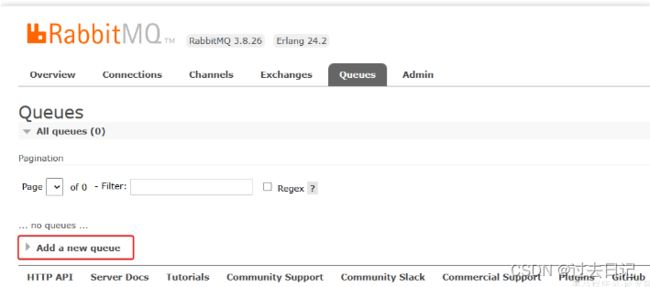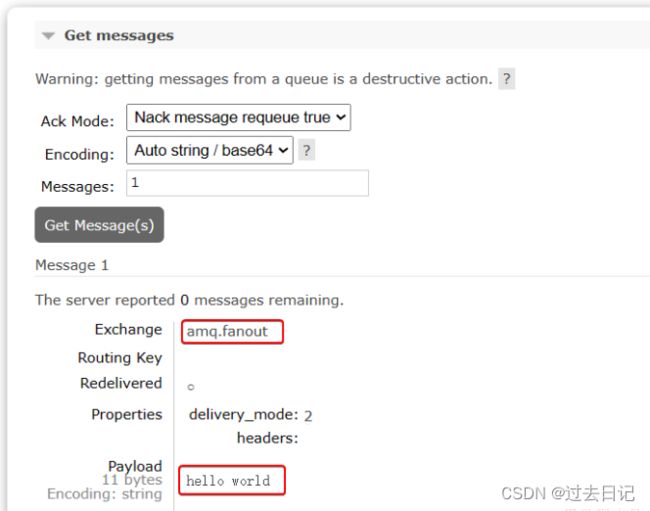spring boot RabbitMq基础教程
RabbitMq
由于RabbitMQ采用了AMQP协议,因此它具备跨语言的特性。任何语言只要遵循AMQP协议收发消息,都可以与RabbitMQ交互。并且RabbitMQ官方也提供了各种不同语言的客户端。
但是,RabbitMQ官方提供的Java客户端编码相对复杂,一般生产环境下我们更多会结合Spring来使用。而Spring的官方刚好基于RabbitMQ提供了这样一套消息收发的模板工具:SpringAMQP。并且还基于SpringBoot对其实现了自动装配,使用起来非常方便。
SpringAMQP提供了三个功能:
- 自动声明队列、交换机及其绑定关系
- 基于注解的监听器模式,异步接收消息
- 封装了RabbitTemplate工具,用于发送消息
概念
**publisher**:生产者,也就是发送消息的一方**consumer**:消费者,也就是消费消息的一方**queue**:队列,存储消息。生产者投递的消息会暂存在消息队列中,等待消费者处理**exchange**:交换机,负责消息路由。生产者发送的消息由交换机决定投递到哪个队列。**virtual host**:虚拟主机,起到数据隔离的作用。每个虚拟主机相互独立,有各自的exchange、queue
交换机
我们打开Exchanges选项卡,可以看到已经存在很多交换机:

我们点击任意交换机,即可进入交换机详情页面。仍然会利用控制台中的publish message 发送一条消息:
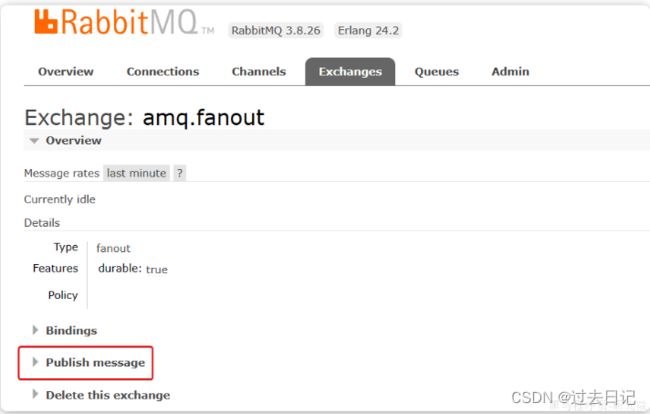
这里是由控制台模拟了生产者发送的消息。由于没有消费者存在,最终消息丢失了,这样说明交换机没有存储消息的能力。
队列
我们打开Queues选项卡,新建一个队列:
再以相同的方式,创建一个队列,密码为hello.queue2,最终队列列表如下:

此时,我们再次向amq.fanout交换机发送一条消息。会发现消息依然没有到达队列!!
发送到交换机的消息,只会路由到与其绑定的队列,因此仅仅创建队列是不够的,我们还需要将其与交换机绑定。
绑定关系
点击Exchanges选项卡,点击amq.fanout交换机,进入交换机详情页,然后点击Bindings菜单,在表单中填写要绑定的队列名称:
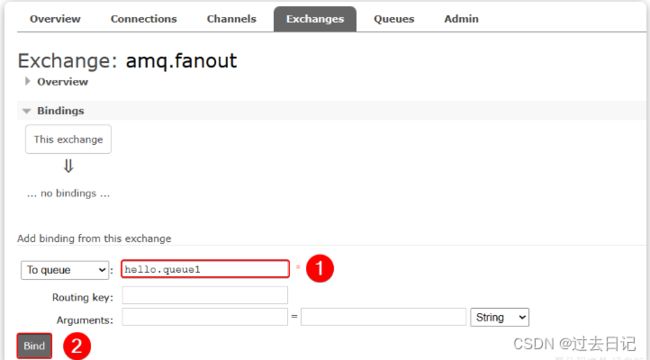
相同的方式,将hello.queue2也绑定到改交换机。
最终,绑定结果如下:

发送消息
再次回到exchange页面,找到刚刚绑定的amq.fanout,点击进入详情页,再次发送一条消息:

回到Queues页面,可以发现hello.queue中已经有一条消息了:

点击队列名称,进入详情页,查看队列详情,这次我们点击get message:

这个时候如果有消费者监听了MQ的hello.queue1或hello.queue2队列,自然就能接收到消息了。
用户管理
点击Admin选项卡,首先会看到RabbitMQ控制台的用户管理界面:
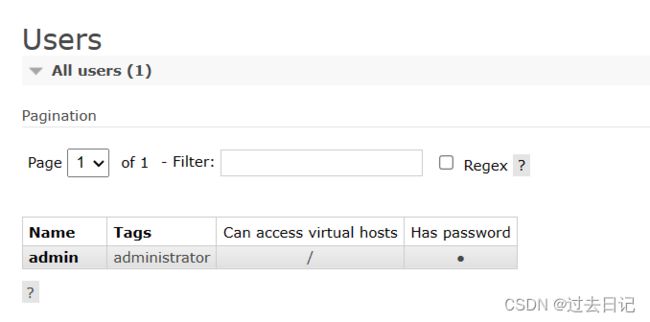
这里的用户都是RabbitMQ的管理或运维人员。目前只有安装RabbitMQ时添加的itheima这个用户。仔细观察用户表格中的字段,如下:
Name:admin,也就是用户名Tags:administrator,说明itheima用户是超级管理员,拥有所有权限Can access virtual host:/,可以访问的virtual host,这里的/是默认的virtual host
对于小型企业而言,出于成本考虑,我们通常只会搭建一套MQ集群,公司内的多个不同项目同时使用。这个时候为了避免互相干扰, 我们会利用virtual host的隔离特性,将不同项目隔离。一般会做两件事情:
- 给每个项目创建独立的运维账号,将管理权限分离。
- 给每个项目创建不同的
virtual host,将每个项目的数据隔离。
交换机
。而一旦引入交换机,消息发送的模式会有很大变化:
可以看到,在订阅模型中,多了一个exchange角色,而且过程略有变化:

- Publisher:生产者,不再发送消息到队列中,而是发给交换机
- Exchange:交换机,一方面,接收生产者发送的消息。另一方面,知道如何处理消息,例如递交给某个特别队列、递交给所有队列、或是将消息丢弃。到底如何操作,取决于Exchange的类型。
- Queue:消息队列也与以前一样,接收消息、缓存消息。不过队列一定要与交换机绑定。
- Consumer:消费者,与以前一样,订阅队列,没有变化
- Exchange(交换机)只负责转发消息,不具备存储消息的能力,因此如果没有任何队列与Exchange绑定,或者没有符合路由规则的队列,那么消息会丢失!
交换机的类型有四种:
- Fanout:广播,将消息交给所有绑定到交换机的队列。我们最早在控制台使用的正是Fanout交换机
- Direct:订阅,基于RoutingKey(路由key)发送给订阅了消息的队列
- Topic:通配符订阅,与Direct类似,只不过RoutingKey可以使用通配符
- Headers:头匹配,基于MQ的消息头匹配,用的较少。
Fanout交换机
Fanout,英文翻译是扇出,我觉得在MQ中叫广播更合适。
在广播模式下,消息发送流程是这样的:

- 1) 可以有多个队列
- 2) 每个队列都要绑定到Exchange(交换机)
- 3) 生产者发送的消息,只能发送到交换机
- 4) 交换机把消息发送给绑定过的所有队列
- 5) 订阅队列的消费者都能拿到消息
我们的计划是这样的:
- 创建一个名为
hmall.fanout的交换机,类型是Fanout - 创建两个队列
fanout.queue1和fanout.queue2,绑定到交换机hmall.fanout
消息发送
在publisher服务的SpringAmqpTest类中添加测试方法:
@Test
public void testFanoutExchange() {
// 交换机名称
String exchangeName = "hmall.fanout";
// 消息
String message = "hello, everyone!";
rabbitTemplate.convertAndSend(exchangeName, "", message);
}
消息接收
在consumer服务的SpringRabbitListener中添加两个方法,作为消费者:
@RabbitListener(queues = "fanout.queue1")
public void listenFanoutQueue1(String msg) {
System.out.println("消费者1接收到Fanout消息:【" + msg + "】");
}
@RabbitListener(queues = "fanout.queue2")
public void listenFanoutQueue2(String msg) {
System.out.println("消费者2接收到Fanout消息:【" + msg + "】");
}
Direct交换机
在Fanout模式中,一条消息,会被所有订阅的队列都消费。但是,在某些场景下,我们希望不同的消息被不同的队列消费。这时就要用到Direct类型的Exchange。

在Direct模型下:
- 队列与交换机的绑定,不能是任意绑定了,而是要指定一个
RoutingKey(路由key) - 消息的发送方在 向 Exchange发送消息时,也必须指定消息的
RoutingKey。 - Exchange不再把消息交给每一个绑定的队列,而是根据消息的
Routing Key进行判断,只有队列的Routingkey与消息的Routing key完全一致,才会接收到消息
- 声明一个名为
hmall.direct的交换机 - 声明队列
direct.queue1,绑定hmall.direct,bindingKey为blud和red - 声明队列
direct.queue2,绑定hmall.direct,bindingKey为yellow和red - 在
consumer服务中,编写两个消费者方法,分别监听direct.queue1和direct.queue2 - 在publisher中编写测试方法,向
hmall.direct发送消息
声明队列和交换机
首先在控制台声明两个队列direct.queue1和direct.queue2,然后声明一个direct类型的交换机,命名为hmall.direct:
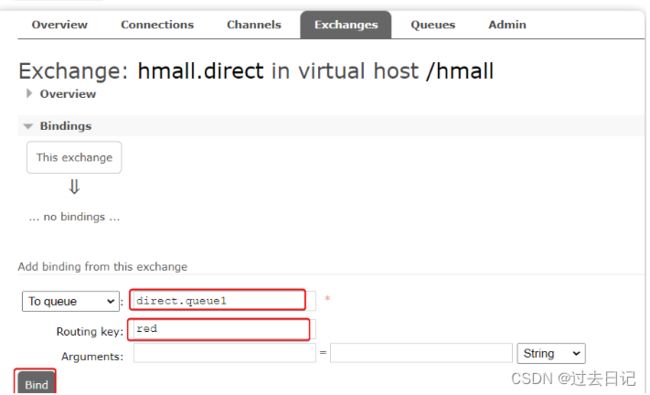
然后使用red和blue作为key,绑定direct.queue1到hmall.direct同理,使用red和yellow作为key,绑定direct.queue2到hmall.direct,步骤略,最终结果:
消息接收
在consumer服务的SpringRabbitListener中添加方法:
@RabbitListener(queues = "direct.queue1")
public void listenDirectQueue1(String msg) {
System.out.println("消费者1接收到direct.queue1的消息:【" + msg + "】");
}
@RabbitListener(queues = "direct.queue2")
public void listenDirectQueue2(String msg) {
System.out.println("消费者2接收到direct.queue2的消息:【" + msg + "】");
}
消息发送
在publisher服务的SpringAmqpTest类中添加测试方法:
@Test
public void testSendDirectExchange() {
// 交换机名称
String exchangeName = "hmall.direct";
// 消息
String message = "红色警报!日本乱排核废水,导致海洋生物变异,惊现哥斯拉!";
// 发送消息
rabbitTemplate.convertAndSend(exchangeName, "red", message);
}
由于使用的red这个key,所以两个消费者都收到了消息:
我们再切换为blue这个key:
@Test
public void testSendDirectExchange() {
// 交换机名称
String exchangeName = "hmall.direct";
// 消息
String message = "最新报道,哥斯拉是居民自治巨型气球,虚惊一场!";
// 发送消息
rabbitTemplate.convertAndSend(exchangeName, "blue", message);
}
你会发现,只有消费者1收到了消息:
总结
描述下Direct交换机与Fanout交换机的差异?
- Fanout交换机将消息路由给每一个与之绑定的队列
- Direct交换机根据RoutingKey判断路由给哪个队列
- 如果多个队列具有相同的RoutingKey,则与Fanout功能类似
交换机
说明
Topic类型的Exchange与Direct相比,都是可以根据RoutingKey把消息路由到不同的队列。
只不过Topic类型Exchange可以让队列在绑定BindingKey 的时候使用通配符!
BindingKey 一般都是有一个或多个单词组成,多个单词之间以.分割,例如: item.insert
通配符规则:
#:匹配一个或多个词*:匹配不多不少恰好1个词
举例:
item.#:能够匹配item.spu.insert或者item.spuitem.*:只能匹配item.spu
假如此时publisher发送的消息使用的RoutingKey共有四种:
china.news代表有中国的新闻消息;china.weather代表中国的天气消息;japan.news则代表日本新闻japan.weather代表日本的天气消息;
解释:
topic.queue1:绑定的是china.#,凡是以china.开头的routing key都会被匹配到,包括:china.newschina.weather
topic.queue2:绑定的是#.news,凡是以.news结尾的routing key都会被匹配。包括:china.newsjapan.news
接下来,我们就按照上图所示,来演示一下Topic交换机的用法。
首先,在控制台按照图示例子创建队列、交换机,并利用通配符绑定队列和交换机。此处步骤略。最终结果如下:

消息发送
在publisher服务的SpringAmqpTest类中添加测试方法:
/**
* topicExchange
*/
@Test
public void testSendTopicExchange() {
// 交换机名称
String exchangeName = "hmall.topic";
// 消息
String message = "喜报!孙悟空大战哥斯拉,胜!";
// 发送消息
rabbitTemplate.convertAndSend(exchangeName, "china.news", message);
}
消息接收
在consumer服务的SpringRabbitListener中添加方法:
@RabbitListener(queues = "topic.queue1")
public void listenTopicQueue1(String msg){
System.out.println("消费者1接收到topic.queue1的消息:【" + msg + "】");
}
@RabbitListener(queues = "topic.queue2")
public void listenTopicQueue2(String msg){
System.out.println("消费者2接收到topic.queue2的消息:【" + msg + "】");
}
声明队列和交换机
在之前我们都是基于RabbitMQ控制台来创建队列、交换机。但是在实际开发时,队列和交换机是程序员定义的,将来项目上线,又要交给运维去创建。那么程序员就需要把程序中运行的所有队列和交换机都写下来,交给运维。在这个过程中是很容易出现错误的。
因此推荐的做法是由程序启动时检查队列和交换机是否存在,如果不存在自动创建。
fanout示例
在consumer中创建一个类,声明队列和交换机:
package com.itheima.consumer.config;
import org.springframework.amqp.core.Binding;
import org.springframework.amqp.core.BindingBuilder;
import org.springframework.amqp.core.FanoutExchange;
import org.springframework.amqp.core.Queue;
import org.springframework.context.annotation.Bean;
import org.springframework.context.annotation.Configuration;
@Configuration
public class FanoutConfig {
/**
* 声明交换机
* @return Fanout类型交换机
*/
@Bean
public FanoutExchange fanoutExchange(){
return new FanoutExchange("hmall.fanout");
}
/**
* 第1个队列
*/
@Bean
public Queue fanoutQueue1(){
return new Queue("fanout.queue1");
}
/**
* 绑定队列和交换机
*/
@Bean
public Binding bindingQueue1(Queue fanoutQueue1, FanoutExchange fanoutExchange){
return BindingBuilder.bind(fanoutQueue1).to(fanoutExchange);
}
/**
* 第2个队列
*/
@Bean
public Queue fanoutQueue2(){
return new Queue("fanout.queue2");
}
/**
* 绑定队列和交换机
*/
@Bean
public Binding bindingQueue2(Queue fanoutQueue2, FanoutExchange fanoutExchange){
return BindingBuilder.bind(fanoutQueue2).to(fanoutExchange);
}
}
direct示例
direct模式由于要绑定多个KEY,会非常麻烦,每一个Key都要编写一个binding:
package com.itheima.consumer.config;
import org.springframework.amqp.core.*;
import org.springframework.context.annotation.Bean;
import org.springframework.context.annotation.Configuration;
@Configuration
public class DirectConfig {
/**
* 声明交换机
* @return Direct类型交换机
*/
@Bean
public DirectExchange directExchange(){
return ExchangeBuilder.directExchange("hmall.direct").build();
}
/**
* 第1个队列
*/
@Bean
public Queue directQueue1(){
return new Queue("direct.queue1");
}
/**
* 绑定队列和交换机
*/
@Bean
public Binding bindingQueue1WithRed(Queue directQueue1, DirectExchange directExchange){
return BindingBuilder.bind(directQueue1).to(directExchange).with("red");
}
/**
* 绑定队列和交换机
*/
@Bean
public Binding bindingQueue1WithBlue(Queue directQueue1, DirectExchange directExchange){
return BindingBuilder.bind(directQueue1).to(directExchange).with("blue");
}
/**
* 第2个队列
*/
@Bean
public Queue directQueue2(){
return new Queue("direct.queue2");
}
/**
* 绑定队列和交换机
*/
@Bean
public Binding bindingQueue2WithRed(Queue directQueue2, DirectExchange directExchange){
return BindingBuilder.bind(directQueue2).to(directExchange).with("red");
}
/**
* 绑定队列和交换机
*/
@Bean
public Binding bindingQueue2WithYellow(Queue directQueue2, DirectExchange directExchange){
return BindingBuilder.bind(directQueue2).to(directExchange).with("yellow");
}
}
基于注解声明
基于@Bean的方式声明队列和交换机比较麻烦,Spring还提供了基于注解方式来声明。
例如,我们同样声明Direct模式的交换机和队列:
@RabbitListener(bindings = @QueueBinding(
value = @Queue(name = "direct.queue1"),
exchange = @Exchange(name = "hmall.direct", type = ExchangeTypes.DIRECT),
key = {"red", "blue"}
))
public void listenDirectQueue1(String msg){
System.out.println("消费者1接收到direct.queue1的消息:【" + msg + "】");
}
@RabbitListener(bindings = @QueueBinding(
value = @Queue(name = "direct.queue2"),
exchange = @Exchange(name = "hmall.direct", type = ExchangeTypes.DIRECT),
key = {"red", "yellow"}
))
public void listenDirectQueue2(String msg){
System.out.println("消费者2接收到direct.queue2的消息:【" + msg + "】");
}
是不是简单多了。
再试试Topic模式:
@RabbitListener(bindings = @QueueBinding(
value = @Queue(name = "topic.queue1"),
exchange = @Exchange(name = "hmall.topic", type = ExchangeTypes.TOPIC),
key = "china.#"
))
public void listenTopicQueue1(String msg){
System.out.println("消费者1接收到topic.queue1的消息:【" + msg + "】");
}
@RabbitListener(bindings = @QueueBinding(
value = @Queue(name = "topic.queue2"),
exchange = @Exchange(name = "hmall.topic", type = ExchangeTypes.TOPIC),
key = "#.news"
))
public void listenTopicQueue2(String msg){
System.out.println("消费者2接收到topic.queue2的消息:【" + msg + "】");
}
消息转换器
而在数据传输时,它会把你发送的消息序列化为字节发送给MQ,接收消息的时候,还会把字节反序列化为Java对象。
只不过,默认情况下Spring采用的序列化方式是JDK序列化。众所周知,JDK序列化存在下列问题:
- 数据体积过大
- 有安全漏洞
- 可读性差
配置JSON转换器
显然,JDK序列化方式并不合适。我们希望消息体的体积更小、可读性更高,因此可以使用JSON方式来做序列化和反序列化。
在publisher和consumer两个服务中都引入依赖:
<dependency>
<groupId>com.fasterxml.jackson.dataformatgroupId>
<artifactId>jackson-dataformat-xmlartifactId>
<version>2.9.10version>
dependency>
注意,如果项目中引入了spring-boot-starter-web依赖,则无需再次引入Jackson依赖。
配置消息转换器,在publisher和consumer两个服务的启动类中添加一个Bean即可:
@Bean
public MessageConverter messageConverter(){
// 1.定义消息转换器
Jackson2JsonMessageConverter jackson2JsonMessageConverter = new Jackson2JsonMessageConverter();
// 2.配置自动创建消息id,用于识别不同消息,也可以在业务中基于ID判断是否是重复消息
jackson2JsonMessageConverter.setCreateMessageIds(true);
return jackson2JsonMessageConverter;
}
消息转换器中添加的messageId可以便于我们将来做幂等性判断。
总结
以上的代码已上传到Github
https://github.com/onenewcode/mq-demo


